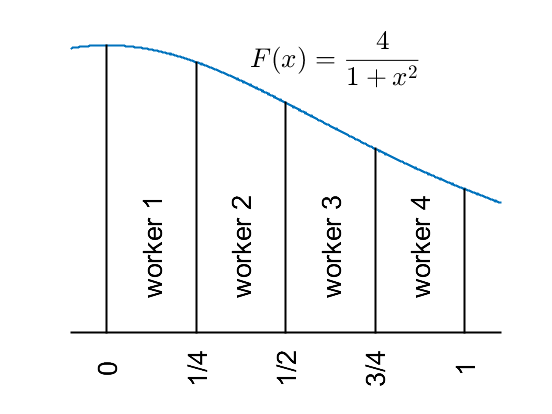Numerical Estimation of Pi Using Message Passing
This example shows the basics of working with spmd statements, and how they provide an interactive means of performing parallel computations. We do this by performing relatively simple computations to approximate pi.
The code shown in this example can be found in this function:
function paralleldemo_quadpi_mpi
Introduction
We intend to use the fact that

to approximate pi by approximating the integral on the left.
We intend to have the parallel pool perform the calculations in parallel, and to use the spmd keyword to mark the parallel blocks of code. We first look at the size of the parallel pool that is currently open.
p = gcp; p.NumWorkers
Starting parallel pool (parpool) using the 'Processes' profile ...
Connected to the parallel pool (number of workers: 6).
ans =
6
Parallelize the Computations
We approximate pi by the numerical integral of 4/(1 + x^2) from 0 to 1.
type pctdemo_aux_quadpi.m
function y = pctdemo_aux_quadpi(x) %PCTDEMO_AUX_QUADPI Return data to approximate pi. % Helper function used to approximate pi. This is the derivative % of 4*atan(x). % Copyright 2008 The MathWorks, Inc. y = 4./(1 + x.^2);
We divide the work between the workers by having each worker calculate the integral of the function over a subinterval of [0, 1] as shown in the picture.

We define the variables a and b on all the workers, but let their values depend on spmdIndex so that the intervals [a, b] correspond to the subintervals shown in the figure. We then verify that the intervals are correct. Note that the code in the body of the spmd statement is executed in parallel on all the workers in the parallel pool.
spmd a = (spmdIndex - 1)/spmdSize; b = spmdIndex/spmdSize; fprintf('Subinterval: [%-4g, %-4g]\n', a, b); end
We let all the workers now use a MATLAB quadrature method to approximate each integral. They all operate on the same function, but on the different subintervals of [0,1] shown in the figure above.
spmd myIntegral = integral(@pctdemo_aux_quadpi, a, b); fprintf('Subinterval: [%-4g, %-4g] Integral: %4g\n', ... a, b, myIntegral); end
Add the Results
The workers have all calculated their portions of the integral of the function, and we add the results together to form the entire integral over [0, 1]. We use the spmdPlus function to add myIntegral across all the workers and return the sum on all the workers.
spmd piApprox = spmdPlus(myIntegral); end
Inspect Results in the Client
Since the variable piApprox was assigned to inside an spmd statement, it is accessible on the client as a Composite. Composite objects resemble cell arrays with one element for each worker. Indexing into a Composite brings back the corresponding value from the worker to the client.
approx1 = piApprox{1}; % 1st element holds value on worker 1.
fprintf('pi : %.18f\n', pi);
fprintf('Approximation: %.18f\n', approx1);
fprintf('Error : %g\n', abs(pi - approx1))
pi : 3.141592653589793116 Approximation: 3.141592653589793116 Error : 0